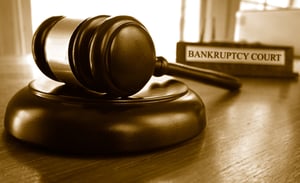
In a Chapter 13 bankruptcy case, the debtor must pay all of their disposable income towards their debts in a three to five-year repayment plan before their remaining debts are discharged. However, a bankruptcy discharge does not automatically erase creditors' lien on your property. Disposable income remains after paying the debtor’s normal monthly expenses. This differs from a chapter 7 bankruptcy case, in which the debtor is not required to make payments towards their debts before receiving a discharge a few months after their case is filed.
.
Why Chapter 13? A Deeper Look
Debtors typically are in Chapter 13 because they earn too much income to qualify for a Chapter 7 case; they have a lot of extra property that would be taken to pay creditors in Chapter 7 (the debtor keeps all their property in Chapter 13), or to mitigate the negative consequences of certain improper financial transactions that occur before filing for bankruptcy (elaborated upon in other blogs). Seeking advice from a qualified bankruptcy attorney can help determine if filing for bankruptcy is viable.
Creditors may sue individuals for not repaying loans, resulting in an involuntary judgment lien.
Due to the fact that chapter 13 repayment plans last for a while, it is common for the debtor to want to sell their home or secure refinancing of a mortgage during the course of their case. However, in order to do so, the debtor will often be required to eliminate any liens against their property that create an encumbrance hindering their ability to procure clear title to the property.
The Need for Clear Title: Resolving Encumbrances
One such type of lien is a judgment lien, a lien against the property created when a creditor sues the debtor and receives a court judgment against them. The creditor can then ask the court to take the judgment and make a lien against the debtor’s property, or if the judgment is entered in the county where the debtor’s real property sits, the judgment will automatically become a lien against the debtor’s property.
If the lien against the debtor’s property is a judicial lien, the debtor may be able to “avoid” or remove it. To do so, the debtor must file a motion in their Chapter 13 case asking the court to remove the lien. The bankruptcy court handles filing these motions to avoid liens, ensuring that the debtor's rights are protected.
The court will grant the motion and remove the lien if the debtor can show that the judicial lien impairs the debtor’s right to claim the property as “exempt,” meaning legally protected under the law from being taken to pay creditors.
Without going into too much detail, debtors who file in bankruptcy in Minnesota are almost always able to claim their home as exempt, as State law exempts and protects the debtor’s primary residence, along with the land upon which it sits, to up to $450,000 in equity (the value of the property over any mortgages and any other debts secured by the property).
Understanding Judicial Liens and Exemption Rights
If the mortgage balance and the amount of the claimed exemption exceed the property's value, any judicial liens against the property will be deemed to impair and interfere with the debtor’s right to exempt the property. The court will allow the debtor to avoid and remove any and all such judicial liens against the property. Lien stripping is a process under Chapter 13 bankruptcy that allows debtors to remove unsecured junior liens through repayment plans.
For example, a debtor’s home is valued at $200,000 with a mortgage balance of $100,000. Under State law, the debtor’s equity will be exempt, and the combination of the mortgage balance and the claimed exemption will far exceed the home's value ($100,000+$450,000=$550,000>$200,000). In such a case, the court will grant the debtor’s motion to avoid and remove any existing judgment liens, freeing the debtor to sell the home or gain refinancing with a clear title.
JUDGMENT LIENS VS. OTHER LIENS: KNOW THE DIFFERENCE
It’s crucial to differentiate between judicial liens and other types of liens. Involuntary statutory liens are placed on a property without the owner's agreement, usually due to unpaid taxes or bills for work. While judicial liens arise from court judgments, other liens, like tax or mechanic’s liens, are not avoidable through the same process in Chapter 13 bankruptcy. A statutory lien differs from other types of liens in that it is placed on a debtor's property without their agreement, often due to unpaid taxes or bills for work done on the property. These other liens may require different strategies or negotiations with the creditors. A knowledgeable bankruptcy attorney can help you identify the types of liens you’re facing and develop a plan to address them effectively.
THE TIMING OF LIEN AVOIDANCE
Timing is critical when seeking to avoid judicial liens in a Chapter 13 case. Generally, the motion to avoid liens is filed after your repayment plan is confirmed but before your discharge is granted. Avoiding involuntary judgment liens involves filing a motion in court, which can help protect your property with exemptions in Chapter 7 bankruptcy.
However, some courts may allow for lien avoidance at plan confirmation. It’s essential to consult with your attorney to determine the appropriate timing for your specific case.
THE ROLE OF THE CHAPTER 13 TRUSTEE
The Chapter 13 trustee plays a crucial role in the lien avoidance process. They review your motion, assess the validity of the liens, and may object if they believe the liens are not impairing your exemptions. It's important to work collaboratively with the trustee and provide all necessary documentation to support your motion.
PROTECTING YOUR VEHICLE: LIEN AVOIDANCE BEYOND THE HOMESTEAD
While avoiding liens on your home is common, you can also avoid judicial liens on other exempt property, like your vehicle. Voluntary liens are liens that individuals agree to when borrowing money to purchase items like personal property, real property, jewelry, or appliances. The same principles apply—if the lien impairs your exemption, you may be able to remove it. However, the exemption limits for vehicles are generally lower than those for homes, so careful calculation is necessary.
LIEN AVOIDANCE AND YOUR CREDIT SCORE
Avoiding a judicial lien in bankruptcy does not automatically remove the underlying debt. The creditor still has a claim against you, but it becomes an unsecured claim rather than a secured one. While this can improve your financial situation, it may also temporarily negatively impact your credit score. However, rebuilding your credit is achievable with responsible financial habits post-bankruptcy.
STRATEGIC LIEN AVOIDANCE: A TOOL FOR FINANCIAL RECOVERY
Avoiding judicial liens isn’t just about removing a burden from your property; it’s a strategic tool for broader financial recovery. However, it's important to note that tax or mortgage liens cannot be avoided in Chapter 7 bankruptcy, highlighting the limitations regarding the stripping or avoiding such liens. Eliminating these liens increases your chances of obtaining favorable mortgage refinancing, accessing home equity, or selling your property without complications. This can free up resources for other financial goals, such as paying down high-interest debt, saving for retirement, or investing in your future.
SEEK PROFESSIONAL GUIDANCE FOR A SMOOTH PROCESS
Understanding the legal intricacies of lien avoidance can be complex. An experienced bankruptcy attorney can guide you through the process, ensuring all necessary paperwork is filed correctly and advocating for your rights in court. By seeking professional assistance, you can maximize your chances of successfully avoiding judicial liens and achieving a fresh financial start.
This blog is designed to provide a general overview of avoiding judicial liens in a Chapter 13 bankruptcy case. As bankruptcy law can be complex at times, it is advisable that a person considering filing for bankruptcy first consult with an experienced bankruptcy attorney. See us at LifeBackLaw.com!





